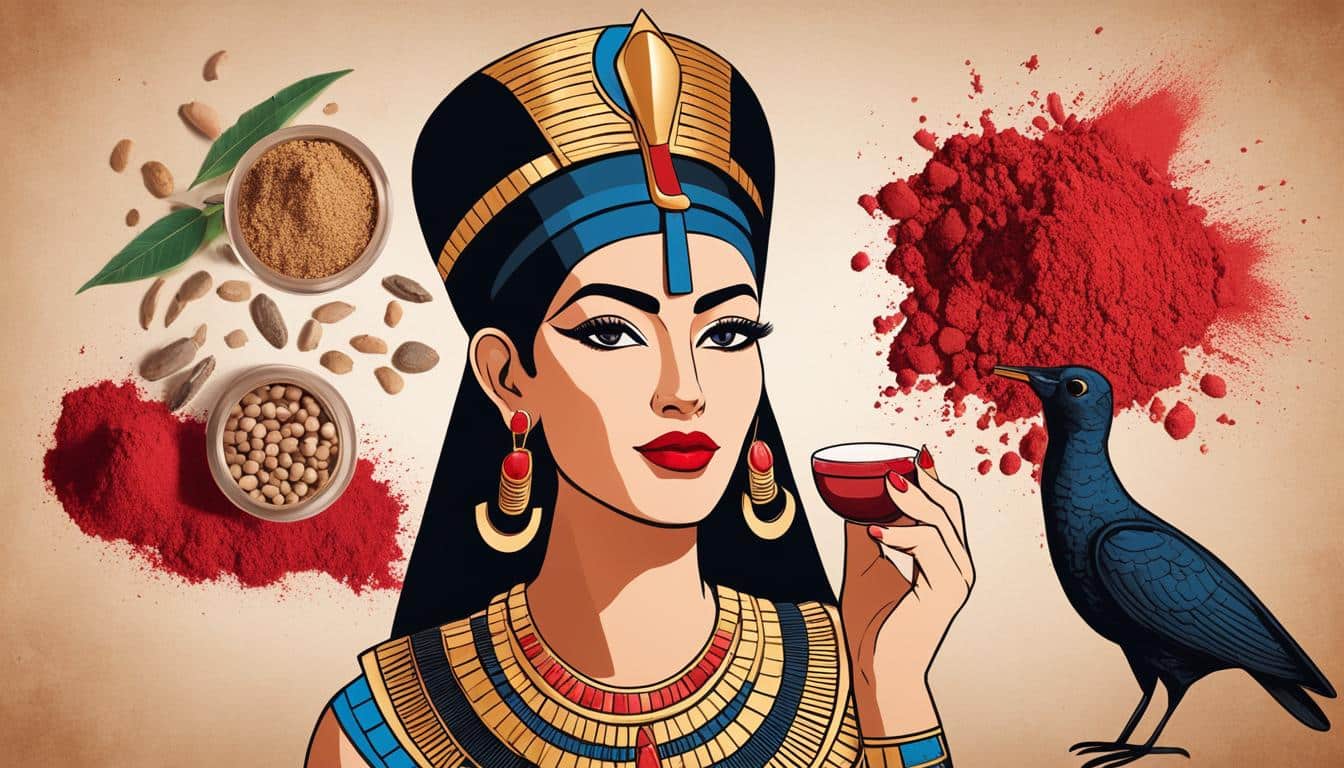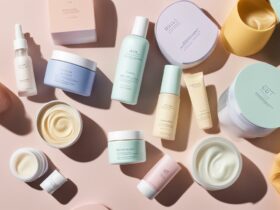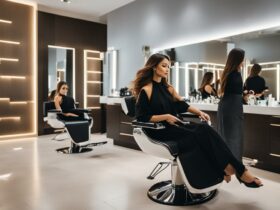Welcome to our journey through the fascinating history of lipstick. Have you ever wondered when lipstick was first invented and how it has evolved over time? Let’s dive in and explore the origins of this iconic cosmetic and its significance throughout the ages.
Lipstick has a rich history that dates back thousands of years. Its origins can be traced back to the ancient Sumerians around 3500 BC, even before the time of the Egyptians. Back then, lipstick took various forms – from mixtures of white lead and crushed semi-precious stones worn by Queen Schub-Ad of Ur, to purplish hues made from seaweed and animal fat used by the Egyptians.
Throughout history, lipstick was initially reserved for the nobility and aristocracy, symbolizing wealth and status. However, it wasn’t until Hollywood emerged in the early 1900s that lipstick became more widely popularized. The influence of the film industry brought bright red shades into the spotlight, making lipstick an essential part of beauty routines for women around the world.
Fast forward to the present day, and lipstick has become a symbol of self-expression and femininity. With an ever-growing range of shades, formulations, and finishes, there’s a lipstick out there for everyone.
Key Takeaways:
- The history of lipstick dates back thousands of years, predating the Egyptians.
- Lipstick was initially reserved for the nobility and became more widespread with the rise of Hollywood.
- Over the years, lipstick has evolved to address different trends and preferences.
- Today, lipstick is a symbol of self-expression and femininity.
- There is a wide range of lipstick shades and formulations available to suit diverse preferences.
Lipstick Through the Ages: An Evolution of Cosmetic History
Lipstick has undergone a fascinating evolution throughout history, mirroring the ever-changing beauty standards and cultural beliefs of different civilizations. From the use of ancient ingredients like crushed beetles and pigments to the invention of synthetic dyes, lipstick has continually transformed over time.
In ancient times, lip color held great significance and was closely tied to social status. It often served as a symbol of wealth and power, with different shades representing various meanings. For example, in ancient Egypt, red lipstick made from ochre and henna signified high social standing.
The popularity of lipstick fluctuated throughout history, with periods of acceptance and disdain. In medieval Europe, lipstick was associated with sin and Satan, leading to its condemnation by the Catholic Church. However, during the Elizabethan era, Queen Elizabeth I popularized the use of lipstick to highlight her pale complexion, and it soon became fashionable once again.
The packaging and manufacturing processes of lipstick also evolved significantly over time. In the early 20th century, metal tubes were introduced, revolutionizing the way lipstick was stored and applied. Previously, lip pigments were wrapped in paper or stored in jars, making them less hygienic and less convenient to use.
“Lipstick has evolved significantly over time, reflecting the changing beauty ideals and cultural beliefs of different civilizations.”
The cosmetic industry continues to innovate, offering a wide range of lipstick shades and formulations to suit diverse preferences. Today, lipsticks are available in various finishes, from matte to glossy, and come in an array of colors to cater to different skin tones.
The evolution of lipstick is a testament to its enduring appeal and its ability to adapt to the ever-changing world of beauty. From its ancient origins to its modern-day prominence, lipstick remains an integral part of cosmetic history and a symbol of self-expression and femininity.
The Science Behind Lipstick Formulation and Production
Lipstick formulation is an intricate process that involves selecting the perfect combination of ingredients. This ensures that the lipstick achieves the desired texture, color, and longevity. Several components play a crucial role in creating a high-quality lipstick.
One of the key ingredients in lipstick formulation is waxes. Waxes such as beeswax, carnauba wax, and candellila wax provide structure and form to the lipstick. These waxes give the product its shape and ensure that it glides smoothly on the lips.
Oils and pigments are also essential components of lipstick. Oils, such as castor oil or lanolin, contribute to the lipstick’s moisture and add to its creamy consistency. Pigments, on the other hand, give the lipstick its color and aesthetic appeal. These pigments can be derived from natural sources or can be synthetic, allowing for a wide range of vibrant shades.
The melting point of the waxes used in lipstick formulation is a critical consideration. It determines the softness of the final product and greatly affects the lipstick’s application and longevity on the lips. By carefully selecting waxes with specific melting points, cosmetic manufacturers can create lipsticks that meet various consumer preferences.
Advancements in technology have revolutionized the production of lipsticks. Automation has streamlined the lipstick production process, allowing for faster and more efficient manufacturing. Molding machines have been developed to create consistent and precise lipstick shapes. These machines enable large-scale production, ensuring that consumers have access to a wide range of lipstick options in the market.
Silicones also play a significant role in lipstick production. They allow for the seamless filling of lipstick bullets into the tubes, ensuring a smooth application. Silicones provide flexibility and efficiency in the production process, facilitating greater customization and branding options for cosmetic companies.
When discussing lipstick production, it is impossible to ignore the revolutionary invention of the metal lipstick tube in 1915. This innovation transformed the packaging of lipsticks, making them more portable, hygienic, and convenient for consumers. Metal lipstick tubes, often adorned with elegant designs, became a symbol of sophistication and glamour.
The combination of meticulous formulation, advanced production techniques, and innovative packaging has propelled the lipstick industry forward. Lipstick continues to be a beloved cosmetic product, offering a multitude of options to enhance beauty and express individuality.
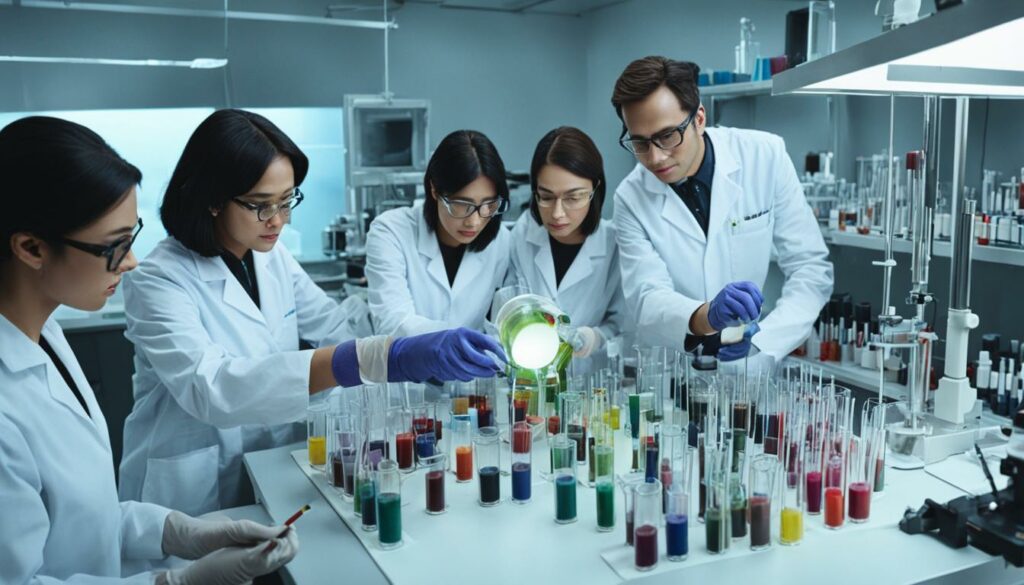
| Ingredients | Function |
|---|---|
| Waxes (e.g., beeswax, carnauba wax, candellila wax) | Provide structure and form |
| Oils (e.g., castor oil, lanolin) | Contribute to moisture and texture |
| Pigments | Add color and aesthetic appeal |
| Silicones | Facilitate seamless filling and customization |
Lipstick Packaging: From Ancient Egypt to Modern Times
Lipstick packaging has undergone a remarkable transformation throughout history, from its early days in ancient Egypt to the modern designs we see today. In ancient times, lip pigments were stored in simple paper wrappers or stored in jars, but advancements in packaging have revolutionized the way we use and carry our favorite lipsticks.
“The invention of the metal lipstick tube in 1915 by Maurice Levy and James Bruce Mason Jr. transformed the industry, making lipsticks more practical, portable, and hygienic.”
The metal lipstick tube became a game-changer in lipstick packaging, offering convenience and improved hygiene. Made of durable materials, these tubes encased the lipstick bullet firmly, protecting it from damage and ensuring it remained intact during travel. The addition of levers or swivel mechanisms made it easy for users to apply lipstick effortlessly.
Evolving Designs and Materials
Modern lipstick packaging offers a wide array of designs and materials, allowing for personalization, branding, and aesthetic appeal. Brands now have the opportunity to create unique and eye-catching packaging that reflects their identity while also capturing the attention of consumers. From sleek and minimalist designs to bold and intricate patterns, lipstick containers have become an extension of the product itself.
The materials used for lipstick packaging have also evolved. While metal tubes are still popular, other options such as plastic and glass have gained popularity due to their versatility and eco-friendliness. Some brands even incorporate sustainable materials and innovative features like refillable lipstick containers to reduce waste and promote sustainability.
The Popularity of Lipstick Packaging
The evolution of lipstick packaging has played a significant role in the popularity and widespread use of this cosmetic product. As lipstick became more practical, portable, and accessible through innovative packaging, it became a staple in beauty routines worldwide. The combination of functional and visually appealing packaging has added to the allure of lipsticks, making them not only a cosmetic essential but also a fashion statement.
Let’s take a closer look at the various materials used in lipstick packaging:
| Material | Pros | Cons |
|---|---|---|
| Metal | Durable, protects the lipstick bullet, offers a luxurious feel | Can be heavy, limited design options |
| Plastic | Lightweight, wide range of design possibilities, customizable | Less durable, concerns about plastic waste |
| Glass | Elegant and luxurious appearance, recyclable | Fragile, requires careful handling |
The choice of lipstick packaging material often reflects consumer preferences and brand image. Some may prefer the classic elegance of metal, while others may opt for the versatility and eco-friendly nature of plastic or glass.
Ultimately, lipstick packaging has undergone significant transformations, evolving from simple paper and jars in ancient times to the practical and visually appealing designs we enjoy today. As cosmetic brands continue to innovate and prioritize sustainability, we can expect even more exciting and eco-friendly developments in lipstick packaging in the future.
The Allure of Lipstick: Symbolism and Societal Impact
Lipstick has always carried symbolic meanings and had an impact on society. Throughout history, it has been associated with diverse cultural significances and played a role in shaping societal norms and perceptions.
In ancient Greece, lip pigments were often associated with prostitutes, signifying both seduction and immorality. Conversely, in the Middle Ages, the Catholic Church condemned the use of lipstick, considering it sinful and associated with vanity.
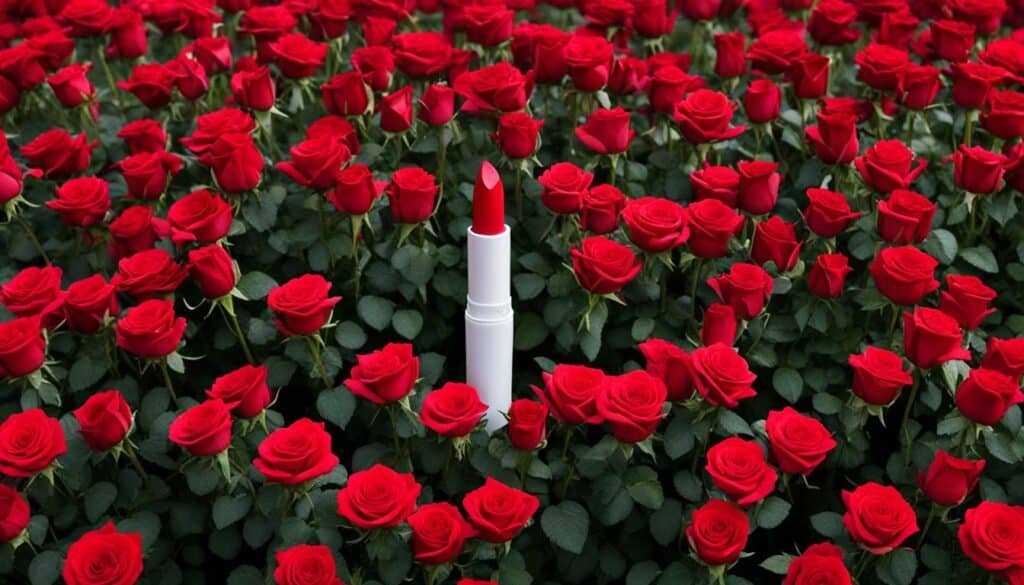
However, lipstick experienced a resurgence thanks to influential figures such as Queen Elizabeth I of England. The queen used lipstick to create a striking contrast with her pale complexion, which became a trend among women of the time.
“All the people of the country look to me, and I must dazzle them so that their eyes may be struck with wonder.”
The suffragette movement in the early 20th century embraced lipstick as a symbol of emancipation and empowerment. Women wore bold lipstick colors to challenge societal norms and assert their independence.
During times of war, lipstick also took on a symbolic role. For example, during World War II, red lipstick symbolized patriotism and was worn by women as a form of resistance and solidarity.
Today, the symbolism and impact of lipstick transcend cultural boundaries. It has become a tool of self-expression, confidence, and empowerment for women worldwide. Whether it be the timeless allure of a classic red or the bold statement of an unconventional shade, lipstick continues to hold cultural significance and plays a role in shaping societal ideals of beauty and femininity.
The Enduring Appeal of Red Lipstick
Red lipstick has a rich history in the world of cosmetics, dating back centuries. One iconic figure often associated with red lips is Cleopatra, who used crushed cochineal beetles to achieve a vibrant red hue. Throughout different time periods, red lipstick has remained a symbol of power, sensuality, and femininity.
In the early 20th century, red lipstick gained significant popularity, thanks to the influence of Hollywood and the emergence of iconic film stars like Marilyn Monroe and Elizabeth Taylor. These glamorous women showcased the allure of red lips, inspiring countless individuals to embrace this bold shade.
Over the years, several red lipstick shades have become legendary in the beauty world. Two examples of such iconic shades are “Russian Red” and “Fighting Red.” These vibrant hues have stood the test of time and continue to be loved and cherished by celebrities and everyday individuals alike.
“Red lipstick is the epitome of confidence and sophistication. It has the power to transform any look and make a bold statement.” – Hollywood icon
Red lipstick holds a timeless appeal, exuding confidence and captivating attention. Its ability to make a striking statement remains unmatched, making red lipstick a staple in makeup collections across the globe.
Modern Lipstick Trends and Influences
Lipstick trends are constantly evolving, influenced by changing fashion trends, evolving beauty standards, and the impact of celebrities. From the glitzy and bold looks of the 1980s to the natural and understated styles of the 1990s, lipstick has always reflected the spirit of the times. Let’s explore some of the modern lipstick trends and the influences that shape them.
Celebrity Power: Influencing Lipstick Trends
Celebrities and influencers have a significant impact on the popularity of lipstick shades and finishes. Their endorsements and personal style choices can catapult a particular shade to fame, making it a must-have for beauty enthusiasts worldwide. Take, for example, Taylor Swift and her signature red lip or Katy Perry’s love for vibrant, unconventional hues. These stars have become synonymous with specific lipstick shades, inspiring fans to follow suit and embrace these trendy colors.
The Clean Beauty Movement: Shaping Lipstick Choices
The rise of the clean beauty movement has also influenced the lipstick industry. Consumers are increasingly conscious about the ingredients in their makeup products and seek out healthier and more sustainable options. Clean beauty focuses on using natural and non-toxic ingredients, making eco-friendly packaging choices, and promoting ethical and sustainable practices. As a result, many brands now offer clean and organic lipstick lines, satisfying the demand for cleaner beauty options.
Diversity and Inclusivity: Catering to All Skin Tones
Lipstick brands recognize the importance of inclusivity and diversity, striving to cater to a wide range of skin tones. The demand for lipstick shades that complement various complexions has led to the expansion of color ranges. Brands now offer an extensive selection of shades, ensuring that everyone can find the perfect lipstick to enhance their natural beauty.
The Influence of Social Media: Spreading Lipstick Trends
Social media platforms like Instagram and TikTok have become hotbeds for lipstick trends. Influencers and makeup artists showcase their favorite lipstick shades, creating viral challenges and tutorials that attract millions of views. These platforms have accelerated the spread of lipstick trends, allowing beauty enthusiasts to discover and experiment with new colors and styles.
As trends continue to evolve, one thing remains certain – lipstick will always hold a special place in the world of beauty. It is a versatile tool for self-expression, empowering individuals to embrace their unique style and personality.
Evolution of Lipstick Trends
| Decade | Trend | Influences |
|---|---|---|
| 1980s | Glossy and Shiny Lipsticks | Disco and glam-inspired fashion |
| 1990s | Natural Shades and Lip Liner | Minimalist beauty trends |
| 2000s | Nude and Berry Tones | Popularized by celebrities like Jennifer Aniston |
| 2010s | Matte and Liquid Lipsticks | Kylie Jenner’s lip kit phenomenon |
| 2020s | Diverse Shades and Sustainable Options | Clean beauty movement and inclusivity demands |
Conclusion
Lipstick’s journey through history is a testament to its enduring allure. From its origins in ancient civilizations to its prominent place in modern beauty routines, lipstick has evolved and adapted to reflect changing trends, ideals, and technological advancements. It has been a powerful symbol of self-expression, femininity, and individuality for women around the world.
Throughout the centuries, lipstick has witnessed societal shifts and cultural influences, continuously reinventing itself to meet the needs and desires of different generations. From the vibrant hues of ancient Egypt to the iconic red shades popularized by Hollywood, lipstick has left an indelible mark on our collective beauty consciousness.
Today, lipstick continues to captivate, with a diverse array of shades, finishes, and formulations that cater to every preference and style. Whether it’s the timeless elegance of red lipstick or the natural beauty of nude shades, lipstick remains an essential tool for self-expression and a symbol of confidence for individuals of all backgrounds.
As we look to the future, lipstick will undoubtedly continue to evolve, embracing new trends, ingredients, and technologies. It will continue to be a steadfast companion in our beauty journeys, celebrating the rich history and endless possibilities of cosmetic artistry.
FAQ
When was lipstick invented?
Lipstick has been used for thousands of years and can be traced back to ancient civilizations such as the Sumerians around 3500 BC.
What were the earliest ingredients used in lipstick?
The earliest ingredients used in lipstick included white lead and crushed semi-precious stones by Queen Schub-Ad of Ur, and purplish hues made from seaweed and animal fat by the Egyptians.
How did lipstick evolve over time?
Over the years, lipstick evolved to address different trends and preferences. Advancements in technology led to the invention of synthetic dyes, allowing for a wider range of colors. Lipstick also became more accessible and popularized through the influence of Hollywood in the 1900s.
What is the science behind lipstick formulation?
Lipstick formulation involves the careful selection of ingredients to achieve the desired texture, color, and longevity. Waxes, oils, and pigments are key components in creating lipstick.
How is lipstick produced?
Lipstick production has been automated with the development of molding machines that streamline the process. Silicones play a crucial role in filling lipsticks, allowing for customization and branding options.
How has lipstick packaging evolved?
Lipstick packaging has come a long way from being wrapped in paper or stored in jars. The invention of the metal lipstick tube in 1915 revolutionized packaging, making lipsticks more practical, portable, and hygienic.
What is the symbolism and societal impact of lipstick?
Throughout history, lipstick has carried symbolic meanings, representing power, sensuality, and femininity. It has also been used as a tool of self-expression and empowerment by various cultures and movements.
Why is red lipstick so iconic?
Red lipstick has been associated with power, sensuality, and femininity throughout different time periods. It became particularly popular in the early 20th century, thanks to Hollywood’s influence and the emergence of film icons.
How do modern lipstick trends and influences shape the industry?
Modern lipstick trends are influenced by changing fashion, beauty standards, and cultural influences. Celebrities play a significant role in shaping lipstick trends, and the rise of the clean beauty movement has impacted the industry.
What is the summary of lipstick history?
Lipstick has a rich and fascinating history, evolving over time to reflect changing beauty ideals, societal norms, and technological advancements. It continues to be a staple in beauty routines and a symbol of self-expression for women worldwide.



